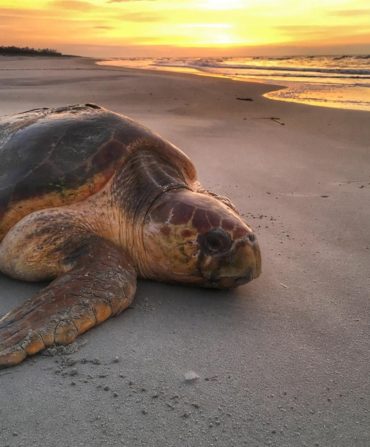Land & Conservation
How to Save a Loggerhead
Go behind the scenes at the South Carolina Aquarium’s Sea Turtle Care Center during a nearly yearlong journey to get a massive injured loggerhead back home
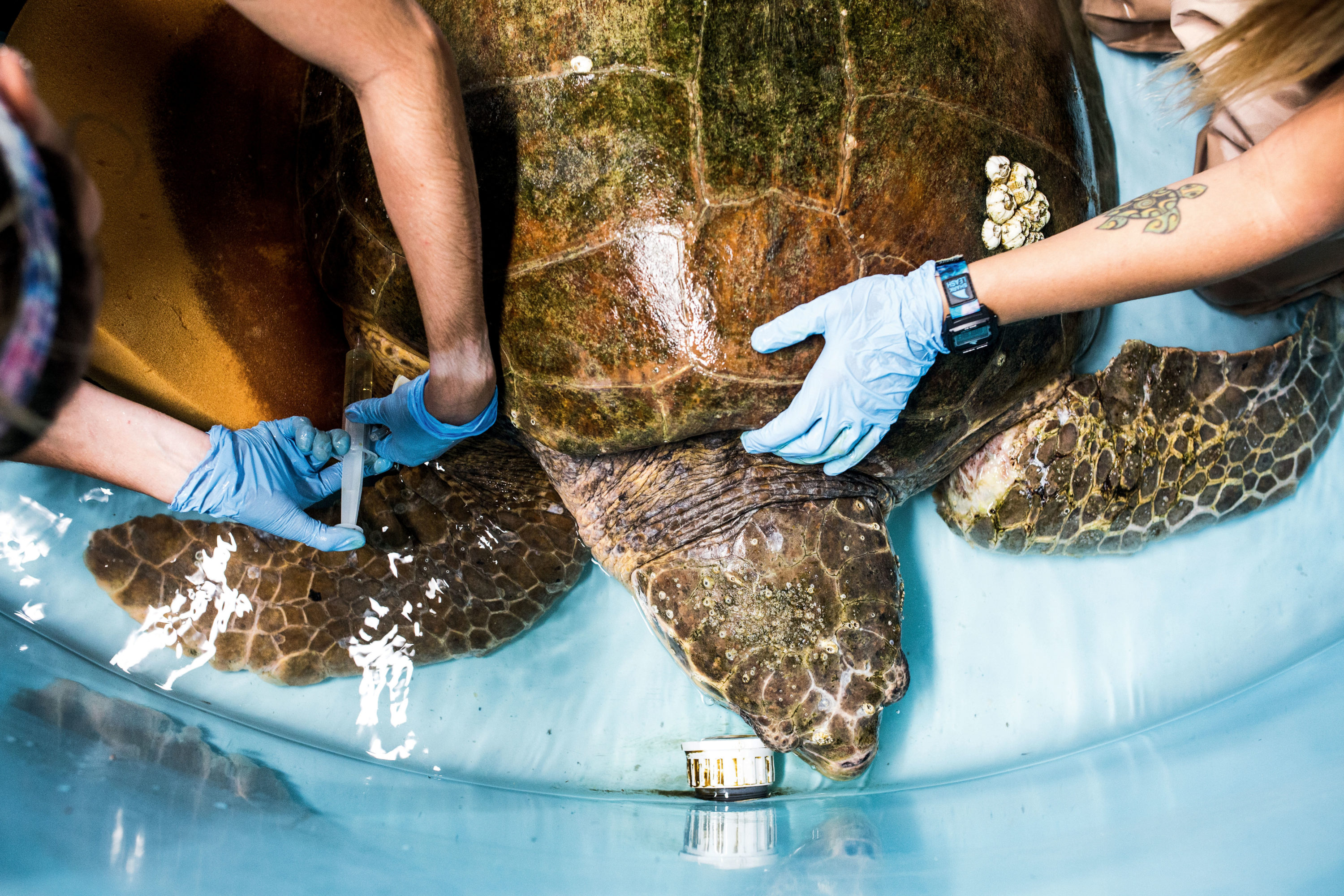
Photo: Nickie Stone
Staff members examine Voldemort and give him a shot of antibiotics shortly after his arrival at the aquarium.
They all had scars.
They had flippers with chunks missing in the shape of shark bites. They had leeches marauding the wounds in their scales. Their shells had been hit by boat propellers, carving howling red divots into the tops of their backs. They had yellow-gray eyelids that opened slowly, and black eyes in the folds underneath, eyes that had always known the ocean—the depths of it, the miles of it—and reflected under hospital lighting the kind of ancient wisdom of whatever it was they had seen. They sighed, turtle sighs, as if their patience in humans had worn thin. They had intestines full of plastic. They had been sucked up into dredges. They had fishing hooks lodged in their mouths, their long reptilian tongues occasionally rising out of their jaws as though they were trying to speak. Two hundred and seventy-five sea turtles over the course of nineteen years, rehabilitated at the South Carolina Aquarium in Charleston and released back into the ocean: Kemp’s ridleys, leatherbacks, loggerheads, and greens, all listed as either endangered or threatened.
Stinky was the first sea turtle brought to the aquarium, bloated from an internal infection and rehabbed in a plastic kiddie pool because there wasn’t a turtle tank when the building opened, in 2000. Channel had a crack near the bottom of her shell. Pirate was ninety-eight pounds of pale green skin, with lockjaw and parasites in her intestines. Ripley was the turtle with the gnarly spinal injury; Little Pritchard had a stingray barb in his elbow joint; Barrington, struck in the head by a boat, required surgery on his brain.
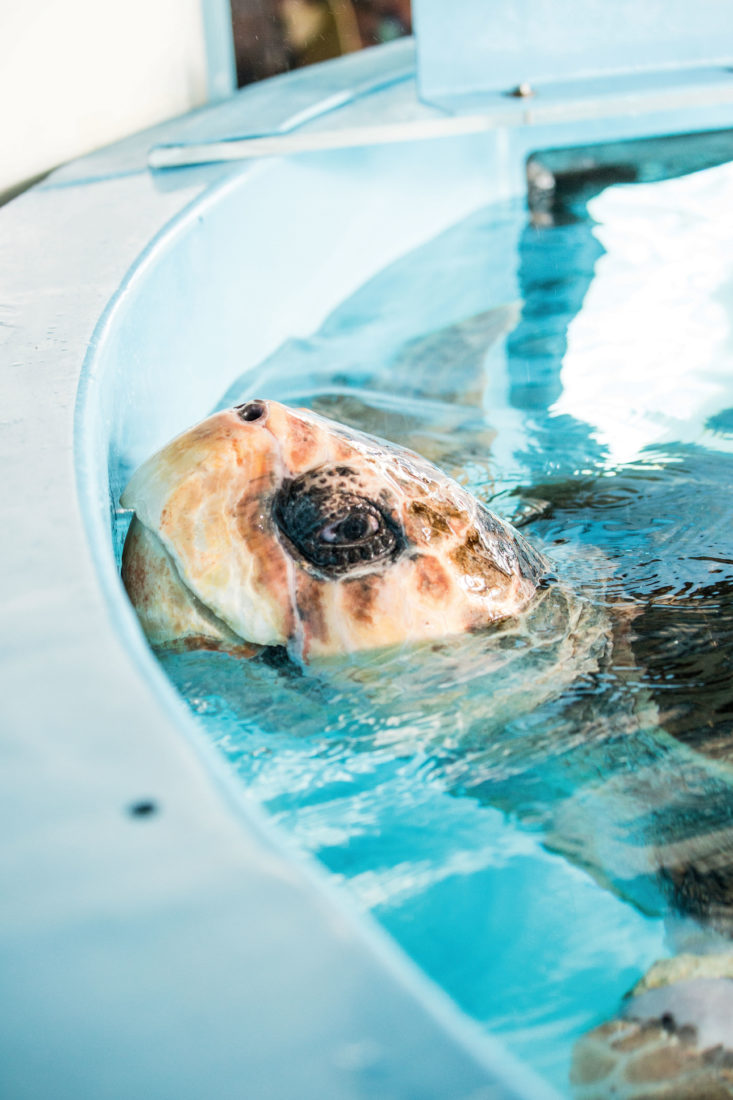
Photo: Nickie Stone
Taking a look around.
One of the biggest turtles the aquarium has ever received was a loggerhead with glistening eyes, a rime of algae and barnacles (epibiota) growing on his face and shell, and an unforgettable scar. He was found near McClellanville, South Carolina, off the coast of the Cape Romain National Wildlife Refuge, a place more densely populated with loggerhead nests than any spot on the East Coast outside of Florida. Four fishermen discovered him—a big shadow moving under the water, two crab buoys dragging behind. Trout fishing on a sunny day, they had been in awe when the turtle’s face emerged near their bay boat for a gulp of air, then saw that his left front flipper was wrapped in crab trap lines, embedded so deep into his skin that they had disappeared. One of the fishermen, Jordan Pate, unsure of what to do, called a fishing buddy—Shane Boylan, the aquarium’s chief veterinarian, who directed him to the Department of Natural Resources turtle hotline.
Half an hour later, two nearby U.S. Fish and Wildlife Service boats notified by the DNR found the turtle at the GPS coordinates Pate provided, and four people eased a mesh sling around the giant turtle’s shell. They managed to drag him to the beach and cut the crab traps loose from the coils of rope still strangling his flipper. Then they brought him to the McClellanville boat ramp, where they met two DNR volunteers, Barb Gobien and Mary Pringle. The two women drove turtles from all over the state to the aquarium’s Sea Turtle Care Center. Pringle backed her white CR-V onto the ramp. It took everyone to get the turtle loaded into the car, his nose touching the back.
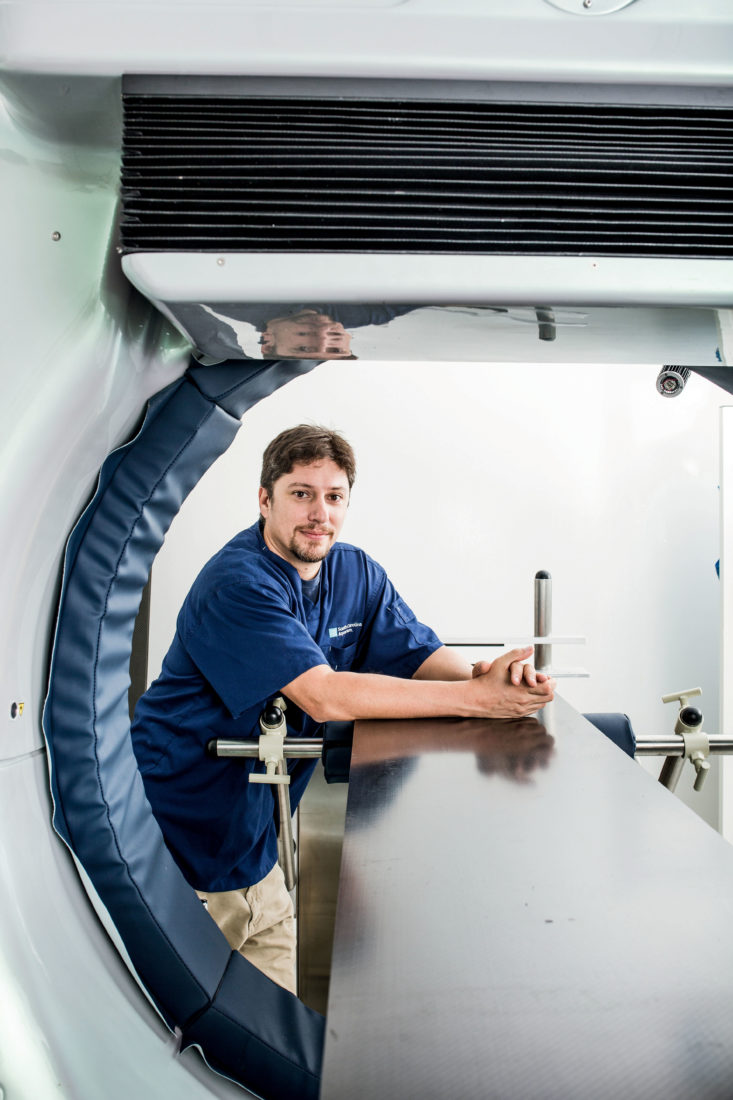
Photo: Nickie Stone
Shane Boylan, the aquarium’s chief vet, in front of the turtle CT scanner.
The turtle arrived at the aquarium’s loading dock just after 4:00 p.m. on June 1, 2018, beneath the palm trees and near the bench with the bronze frog sitting with his leg crossed. A crowd of children were playing tag in the aquarium courtyard. Boylan and eleven other people were waiting for him on the loading dock, anxious to get a look at his flipper. He didn’t yet have a name.
Boylan had always been a fan of naming the turtles. It had become a tradition at the aquarium, a way to remember their idiosyncrasies and scars. Turtles were funny, after all. They had nuances. They were sometimes finicky eaters. They could be grumpy. They loved to have their shells scratched with a squeegee.
Sea turtles have never stopped surprising Boylan in his twelve years at the aquarium. Its first full-time vet, he now presides over one of the most modern turtle hospitals in the United States. During his time there, the turtle center has evolved from having one microscope and barely any room for patients to a place with huge new exhibits and a modern med lab, with an ultrasound and a CT scanner imported from Italy that Boylan nicknamed Megatron. In the early days, before the aquarium had two floors devoted to care, Boylan, who is now forty-four, would sometimes take injured turtles home with him. He used modified endotracheal tubes that he’d brought from work to help them breathe, the turtles on blankets next to his bed, his phone alarm going off every fifteen minutes so he could wake up and pump air into the mouths of little Kemp’s ridleys, some of the most endangered sea turtles, trying to keep them alive through the night.
“Everyone has a connection to a turtle,” Boylan said one evening after work. “Everyone’s had a pet turtle. They were one of the animals that, as a kid, I could help. Just getting one across the road, or keeping a raccoon from gnawing it, or holding it long enough so it could heal from a wound. And then I realized very quickly as a kid that baby birds, no matter what you did, they always died. But a turtle gave you a chance.”
Now, squeezed into the back of Pringle’s SUV, wearing sneakers, cargo shorts, and a blue aquarium T-shirt speckled with sweat, he knelt above one of the biggest turtles he’d seen, hoping this one had a chance. His hands, wrapped in blue hospital gloves, reached down slowly to feel its shell as if he were still a kid in North Carolina with one of his turtle pets. The seats, the floor mats, the seat belts—everything inside was coated in the stench of the decaying flipper. The turtle began to rustle, though there was nowhere for it to go. “Eeeaaasy,” Boylan said. Several inches of the flipper, just past the shoulder, were exposed to the bone.
“Remember, they look slow but bite really fast,” Boylan told the gathered staff.
“This turtle is badass,” he concluded as they prepared to move him inside. “This turtle is…Voldemort.”

Photo: Nickie Stone
Voldemort rests in a tank while the staff monitors his progress.
Voldemort was not an amenable turtle, at first. He thrashed his right front flipper in defiance at the humans who wanted to touch him as he held his injured left flipper close to his body. He craned his head over his shoulder, his mouth open, and his eyes seemed to squint in frustration. “He was starving,” Boylan said, “and he was really pissed off.”
All of the stranded turtles brought to the Sea Turtle Care Center in 2018 were named after Harry Potter characters. Laminated pictures from the movies covered the fridge in the turtle exam room on the first floor, where Boylan’s cubicle sat with books on fish diseases and a turtle skull and Chai Spice tea. The room had an operating table at its center and a large hospital light on the ceiling, other staff surrounding Boylan as he stood above turtles in dire straits, often cracking jokes to cut the tension. When Voldemort arrived, there were seventeen other turtles recuperating at the center. Some were cold-stunned turtles that washed up on beaches after sudden drops in temperature, their bodies shutting down. Malnourished and nearly dead, these floated to wherever the ocean deposited them. All told, the aquarium might receive around forty turtles in an average year.
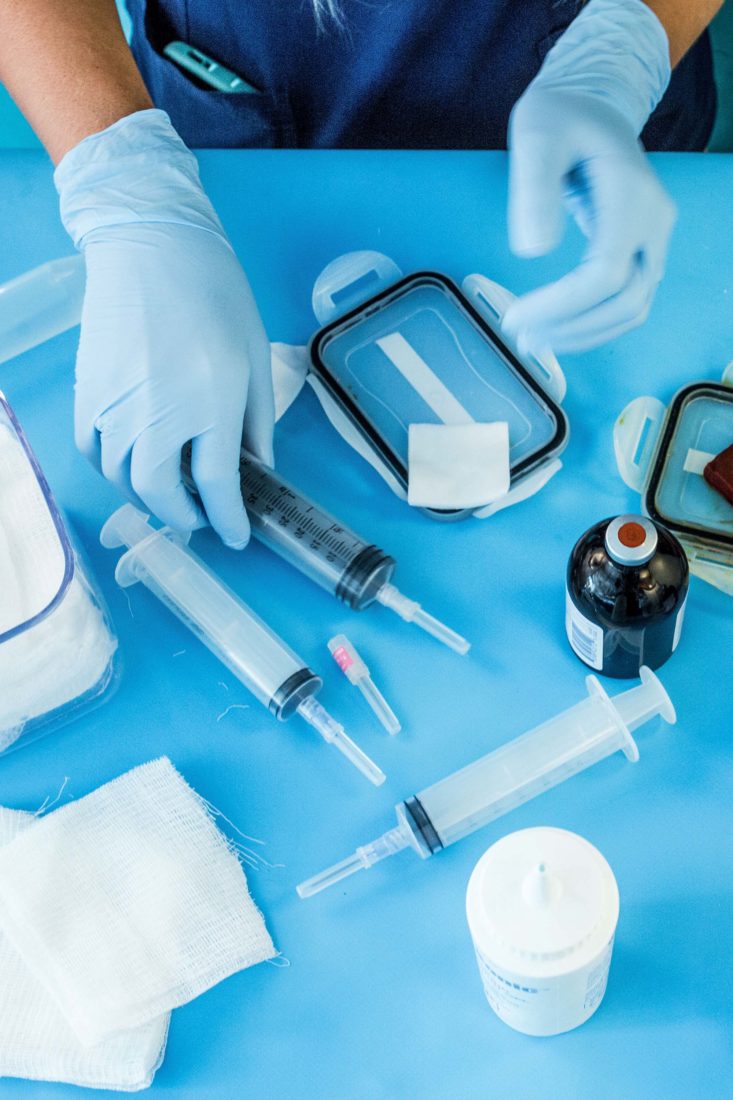
Photo: Nickie Stone
Tools of the trade.
Boylan was constantly fretting about the threats to sea turtles: coastal development, the light pollution affecting hatchlings, plastic and garbage in the water, speedboats, dredges, fishing equipment that could entrap them. Everything that kept sending the turtles to him. “I mean, it’s a life,” he said. “It isn’t a human life, but to me, it’s just as valuable.”
So last season there was Draco Malfoy (cold-stunned and flown down from Boston in December), Luna Lovegood (a spinal injury from a boat and tumors on her legs), Hagrid (debilitated turtle syndrome, a condition that leaves loggerheads emaciated and anemic and covered with algae), and Scabbers, whose left front flipper had been bitten off and who was discovered tangled in fishing gear next to another turtle that was dead. Of course, they’d waited to name one Harry Potter until a seventy-two-pound loggerhead arrived with a jagged scar from a boat strike across its head.
Twelve people huddled behind the white CR-V, trying to hold the squirming turtle down. It took the strength of eight of them to get Voldemort into a crate mounted on a wheeled pallet jack—Boylan and the Sea Turtle Care Center manager, Willow Melamet; a sea turtle biologist, Katelyn McGlothlin; even some big guys from security and IT. They pushed the crate into the freight elevator, up to the first floor, past the Coke machine and the pipes lining the walls, past the area where catering crews gathered with hors d’oeuvres for formal events at the aquarium and often stared as the turtles came by. They went past the surgery room on the left and the CT-scan room, both with windows in back so the public could see inside, and finally into the exam room, this time Boylan and four others lifting Voldemort from the crate onto a cushioned table covered by a blanket. He flapped his healthy right flipper uselessly in the air. He opened his eyes slowly, closed them, and seemed to collapse on the blanket out of exhaustion. Boylan stuck a long needle in his neck and drew blood. They wiped the wound with Betadine gauze, the copper-colored liquid dripping onto the floor. Using a pair of pruning shears, Boylan cut the ropes from the flipper, soaked black from old blood. Everyone agreed that the flipper would most likely have to be amputated. He was an old turtle, they could tell by the size of his tail, and weighed 259 pounds. Loggerheads can live more than fifty years, but there was no way to pinpoint if he was, say, thirty or sixty. Boylan listened to the heartbeat with ultrasound beneath Voldemort’s armpit. It was normal, and that evening, he was wheeled back downstairs into the basement hospital with eleven other turtles, into a one-thousand-gallon tank, eight feet in diameter, first with fresh water to try to help his flipper begin to heal, if it ever would.

Photo: Nickie Stone
A window into the exam room.
The next morning, Voldemort sat on the bottom of the tank, in a single foot of water. “We turn all the lights off at night,” McGlothlin said. “They can hold their breath for four to seven hours. Here they have shallow, warm tanks. He’s kind of inactive. Probably in pain from the wound. It turns out he was healthy except for the wound.” She put a small piece of mackerel in his tank. He wouldn’t eat. There was no miraculous injection they could give him, no more scraping or cleaning the wound. Other than antibiotics, there was little else they could do for his flipper except leave it alone.
After a few weeks, he relaxed in the warm hum of the basement hospital and the comfort of his tank. Voldemort was soon shortened to Voldy, as his personality seemed to soften in the water. Over the next two months, it took a lot of bracing and girding, staff members standing with their feet a certain width apart, to lift him onto a scale when they would check his weight and the condition of his flipper, everyone wearing slick blue gloves and trying to be gentle. It took Boylan and Melamet and Whitney Daniel, the veterinary assistant, and McGlothlin and some herpetologists and the janitor. Pictures of recuperated turtles lined the walls, the only sounds those of the humming pipes and the sloshing of turtles poking their heads up to take a breath. While working with Voldy, the staff was covered in tank water and turtle poo. Boylan stood in the corner one day, decontaminating himself with a water hose.
“These turtles have survived mass extinctions,” he said. “So we fix them, we put them back, and everyone asks me, ‘Don’t you get attached?’ I’m like, ‘No.’ Well, you do a little bit. What I get attached to is that these guys are fighters. Voldy is a fighter. When they come back from injuries like this, I’m amazed. And I’m not even a blip on their radar. All that matters is I got them back out, and maybe they continue the population.”

Photo: Nickie Stone
Staff members briefly remove their hands so Voldemort can be weighed.
Visitors to the aquarium didn’t see Boylan sweating in the basement hospital, sticking IVs in the thick scales of turtles’ necks or with a flashlight in his mouth looking into their throats or cursing under his breath for them to just please give him a little blood. But they did see him in another capacity, as a prominent face of the aquarium’s sea turtle exhibit area, which takes up nearly the entire first floor. A $2.5 million expansion in 2017 provided seven new tanks for recovering turtles, as well as new displays and paintings and life-size turtle replicas. Visitors, often large groups of children, saw Boylan (known just as Shane, or Dr. Shane) as the vet talking in gentle tones in the instructional turtle video on overhead TVs, and saw him in person, in a wet suit, standing in tanks, observing the turtles and helping lift them out for checkups.
Last August a visitor at the aquarium would’ve seen Boylan and a large group of staff wheeling a gigantic turtle from the basement hospital up into the exhibit recovery area for display in a larger tank. Children pointed through glass windows, giggling about how much effort it took to move this turtle, that there were so many people glistening with sweat, that the turtle had a big tail and was wriggling and flapping and didn’t seem to want to cooperate, and that Boylan and Melamet hopped in the tank as the huge turtle slid gently into the water.
By winter, they would’ve seen the turtle swimming in rhythmic circles, slowly getting stronger. They could interact with a touch screen in front of the window and learn about Voldy’s injury, but it would have been hard to tell the extent of it from glancing into the 1,950-gallon tank. The dead skin was gone now. He was using his front left flipper to guide himself around the walls. New, pink skin had grown over the bone.
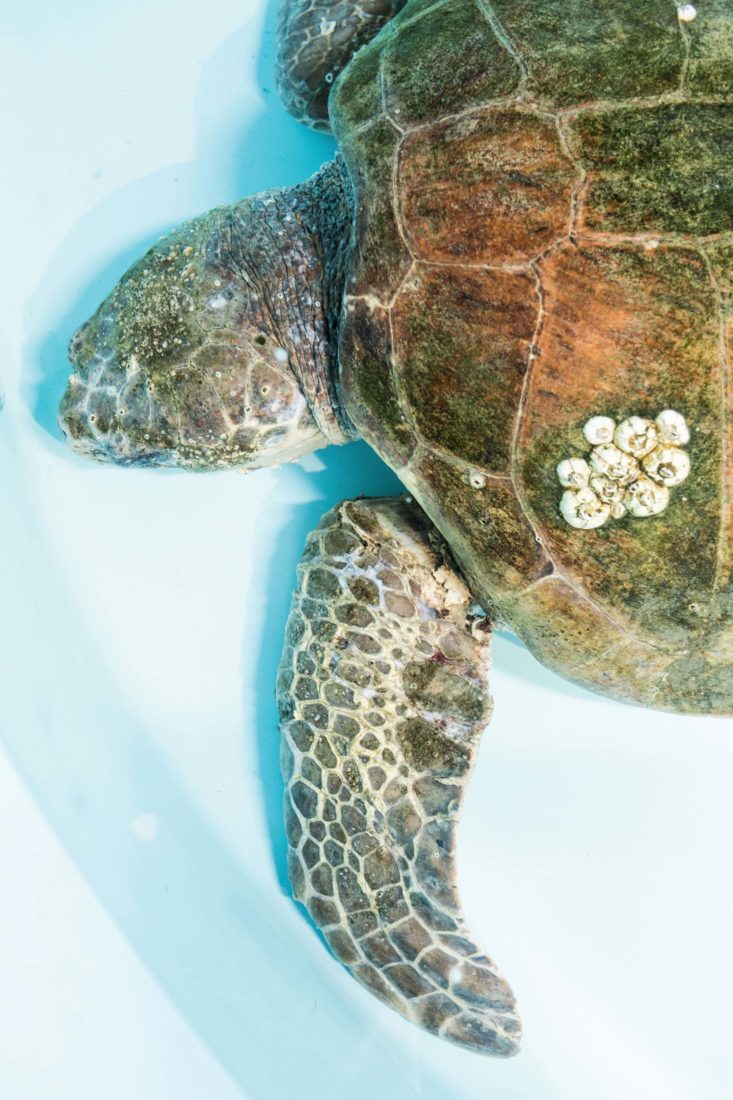
Photo: Nickie Stone
The injured flipper, just after the turtle arrived, which had decayed down to the bone around the shoulder.
Had they come back every day, they would’ve seen someone tossing Voldy frozen fish—fishcicles!—and chunks of mackerel stuffed with vitamin supplements. They would’ve seen Scabbers in the tank on his left and Hagrid, the turtle hairy with algae, on his right. And beyond the seven tanks they would’ve seen turtles painted colorfully on the walls and the turtle theater and a pretend X-ray machine that could be maneuvered through the process of diagnosing internal injuries as though it were real. They would’ve seen, this past April, the staff coming by to take Voldy out of the tank one more time, hefting him out onto a table almost in celebration, to weigh him—315 pounds—his wound completely healed.
On a spring morning in Charleston, a red van headed from the aquarium through downtown. It crossed a bridge and caught the view of the palm trees, the sailboats, the blue horizon, then got stuck in traffic, other drivers rolling their windows down to look at the turtle outline painted on the side. The van lumbered past Woody’s Pizza, where the meatball drops on New Year’s Eve, then past the Tides hotel and the seafood shacks and knickknack shops of Folly Beach. The driver, Mackenzi Polk, a young aquarium sea turtle biologist from Charleston, steered over a path through the dunes, the sand on the road crunching pleasantly under the tires. The van was welcomed by yellow Turtle Center flags and yellow cones planted side by side on a roped-off section of beach, a kind of turtle red carpet. The aquarium had announced the release on its Facebook page, and the small section of beach was full of people who’d come to watch—kids in Gryffindor jerseys and a bare-chested boy with a sign that read: “Voldemort: Slytherin Into The Ocean…”

Photo: Nickie Stone
Voldy arrives at Folly Beach on May 1, 2019.
There were no seats in the back of the van because of the size of the crate that held the giant turtle and two other smaller crates. Melissa Ranly, the sea turtle center’s new manager, had crouched during the drive, spritzing the three turtles with water. Voldy’s tail, in particular, had been getting dry. It was May 1, 10:00 a.m., just shy of a year since Voldy had arrived at the aquarium. He was silent during the trip. The two smaller turtles—Dumbledore and
Scabbers—knocked their flippers impatiently in the crates.
Aquarium staff opened the van’s back doors to the sand below and to loafing clouds in the sky. Twelve people surrounded Voldy one more time, easing him forward in the crate, staggering together onto the beach between the crowds on either side. They carried him, wobbling, to the wet edge of the sand and then set the crate down on the count of three, into the foam. When the crate door was opened, his giant flippers wiggled him forward a little, his tail swaying. He first touched the water with his left front flipper and waited for a second. He raised his head, his eyes black, bulging. His body was not biologically suited for crawling, as male turtles never come back to land after they hatch. The waves hit his face, and he tilted his head up into the sun. It took him about a minute to move a couple of inches, as if he were getting acquainted with the beach, the idea that home was only a foot away. He pushed himself forward, almost hopping on the sand. The crowd on either side oohed. Children sitting on shoulders craned for a better view.
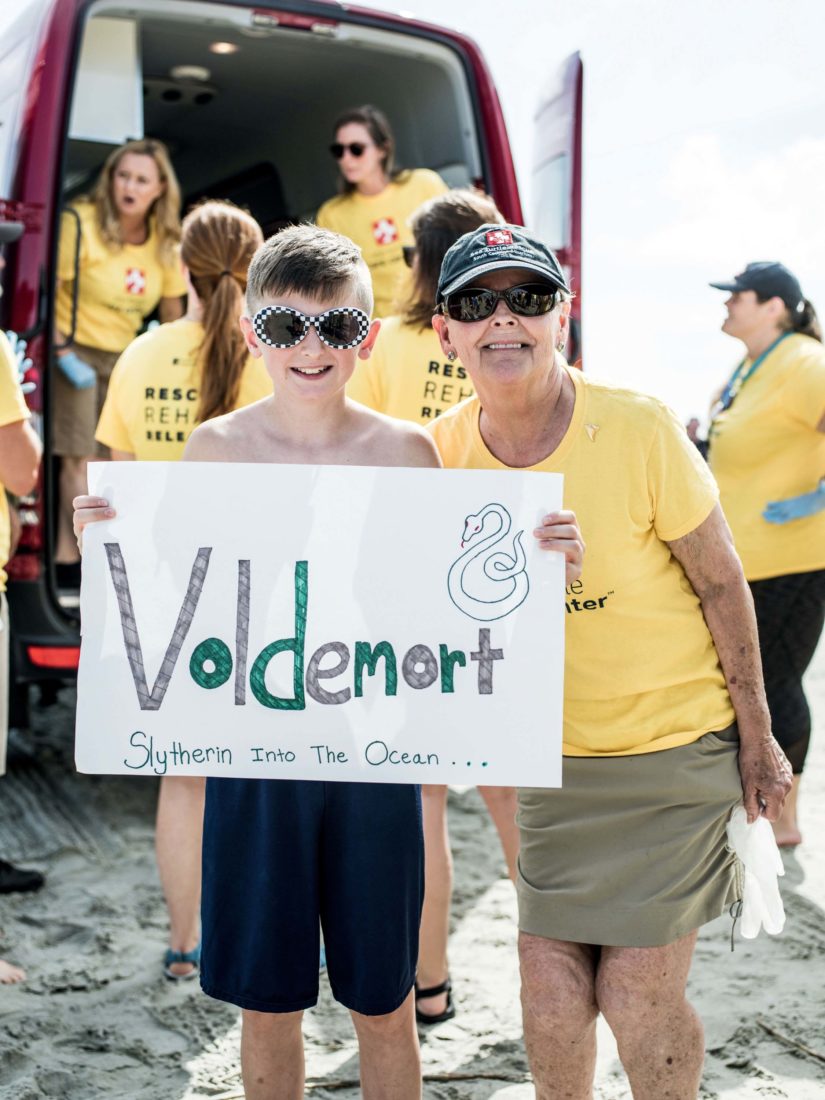
Photo: Nickie Stone
A young fan at Folly Beach to watch Voldy’s release.
He turned left, and a wave submerged his head, then receded, the foam pooling around his flippers. Ranly took her right hand and gave a little push to his shell, hoping to provide some encouragement. The crowd laughed. He crawled slowly out into the ocean, as if it were taking great effort, or contemplation, or just all felt new. It was always a mystery where the turtles might go when they were released. No one really knew, even the people who studied them and cared for them. Maybe he’d try to find a mate, or maybe he’d swim toward the Gulf Stream, sixty miles out. As he moved farther into the water, only his shell remained visible, an old shield gleaming in the sun. The surf foamed over him and over him and over him, until it became difficult to distinguish between the colors of either, to tell what was the turtle and what were the waves.
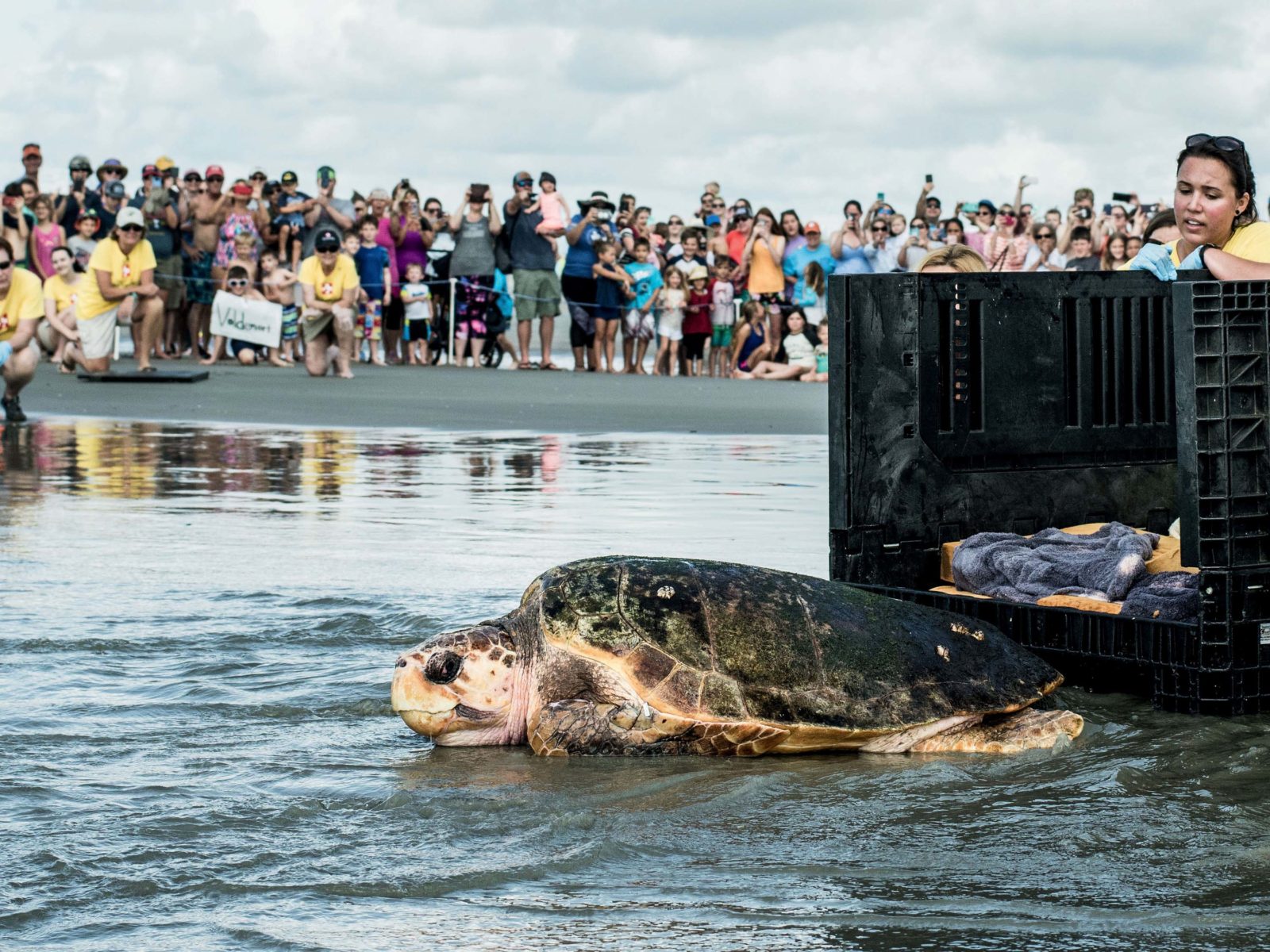
Photo: Nickie Stone
A crowd looks on as Voldy slowly makes his way back into the ocean.


